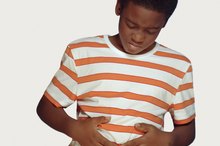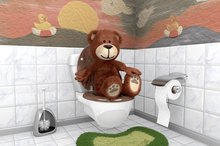Gas Relief for a 2-Year-Old
Gas relief is often found right at home when treating your 2-year-old's gas pains. Gas may come from a variety of sources related to diet or digestion problems. Since gas is usually normal and nothing to worry about, some of the home remedies provide enough relief to get your toddler through the episode 1. But if that's not enough, you may need to contact a physician or use an over-the-counter remedy.
If you are experiencing serious medical symptoms, seek emergency treatment immediately.
Look at the Foods She Eats
Gas is normal and often caused from something your 2-year-old ate hours earlier. Sometimes eating gas-inducing foods such as broccoli, cabbage, beans or dairy products, or drinking juice may cause gas. Some toddlers have a sensitivity to wheat or dairy products and the gas is due to a food allergy. A 2-year-old has more control over his bowels and may hold in the gas so that it's more obvious when he finally releases it. Excessive gas may indicate constipation, especially if you notice your child is not having regular bowel movements. Contact your physician when the gas is excessive or becomes a recurring problem to rule out allergies or other serious problems.
- Gas is normal and often caused from something your 2-year-old ate hours earlier.
- Some toddlers have a sensitivity to wheat or dairy products and the gas is due to a food allergy.
Eliminate the Culprits
Should I Be Worried About My Child's Smelly Gas?
Learn More
If you notice the gas occurring after your child eats specific foods, eliminate the food from his diet. Eliminate your child's consumption of soda, an unnecessary drink with no nutritional value that can cause excessive gas. Increase your child's water intake to eliminate the gas problem. Reduce the amount of juice and dairy you give your child, and remove it from your child's diet entirely while he is experiencing gas pains.
- If you notice the gas occurring after your child eats specific foods, eliminate the food from his diet.
- Reduce the amount of juice and dairy you give your child, and remove it from your child's diet entirely while he is experiencing gas pains.
Offer Gentle Rubbing and Warm Water
Rub your child's stomach in a clockwise motion while he lays on his back. Sometimes moving his legs in a cycling motion can release some of the gas. Place warm heat or water from either a bath, a warm washcloth or a heating pad on your toddler's stomach to relieve the gas pains. The warmth may also relax your child enough that he stops resisting the feeling and he may let the gas naturally release.
- Rub your child's stomach in a clockwise motion while he lays on his back.
- The warmth may also relax your child enough that he stops resisting the feeling and he may let the gas naturally release.
Give Over-the-Counter Remedies
How to Calm a Kid's Upset Stomach
Learn More
Gas drops and gripe water are over-the-counter remedies sometimes recommended to relieve gas pains for immediate relief or when other methods are unsuccessful. Most of these products contain an active ingredient known as simethicone. Follow the warning label for these products. Never give your child more than the recommended dosage and watch for allergic reactions.
- Gas drops and gripe water are over-the-counter remedies sometimes recommended to relieve gas pains for immediate relief or when other methods are unsuccessful.
Related Articles
References
Writer Bio
Sommer Leigh has produced home, garden, family and health content since 1997 for such nationally known publications as "Better Homes and Gardens," "Ladies' Home Journal," "Midwest Living," "Healthy Kids" and "American Baby." Leigh also owns a Web-consulting business and writes for several Internet publications. She has a Bachelor of Science in information technology and Web management from the University of Phoenix.









